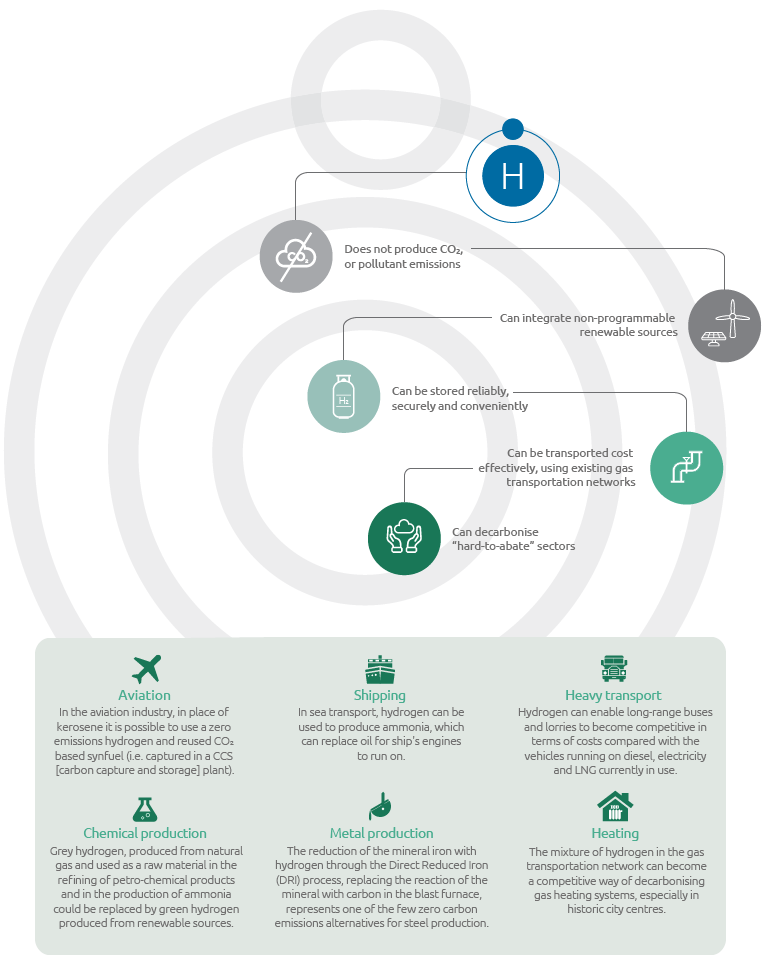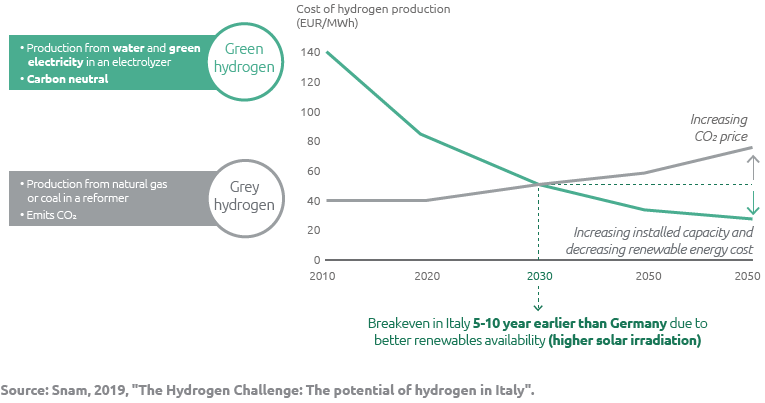The first element
Hydrogen is a clean and versatile source of energy which, if generated from renewable energy and then transported, stored and used as a gas, does not generate emissions of carbon dioxide and other climate-changing gases, or emissions that are damaging to man and the environment. For this reason, it can assume a key role in energy transition and in guaranteeing that the European and global decarbonisation targets are reached by 2050.
Currently, it is mainly employed for industrial uses and is obtained from natural gas, through a thermo-chemical conversion process with the production of CO2 (grey hydrogen). Added to this is the technology for capturing and storing the CO2 (CCS) to obtain decarbonised hydrogen (blue hydrogen). However, the most promising route for the development of hydrogen is the production of “green hydrogen”, generated through electrolysis of water, in which electricity is used to “break down” the water into hydrogen and oxygen without the emission of any CO2 at the point of release.
One of the main advantages of green hydrogen is related to its possible use to integrate the development of non-programmable energy sources, such as wind power and solar power. Specifically, the development of electricity in the national energy mix through non-programmable renewable sources will lead to the need to store energy to balance seasonal peaks in demand. Hydrogen, in a complementary manner to other forms of energy storage, like batteries and reservoirs, could contribute to the balancing of the supply of energy during the year, making it possible, for example to convert the energy produced in summer by photovoltaic plants and store it during the winter months. The possibility of converting energy from non-programmable renewable sources thereby reduces the country’s dependency on specific energy resources and certain exporting countries, increasing energy security and economic advantages.

“Hard-to-abate” are the sectors with an intensive consumption of energy, for which the use of hydrogen could represent a crucial choice in the reduction of emissions
A key characteristic of hydrogen is therefore its capacity to act at the same time as a clean energy source and an energy vector for storage. Added to this is the fact that hydrogen, especially in countries where domestic energy demand is mainly covered using natural gas, can be transported through the existing pipelines, mixed with natural gas and, in the future, in dedicated pipelines. Specifically, in Italy, thanks to the gas infrastructures that connect it to North African countries, where there is plenty of sunshine throughout the year, hydrogen can be produced in great quantities in these countries and transported to Italy and Europe through the national gas network.
Achieving the goal of 100% decarbonisation by 2050 also requires a significant reduction in so-called hard-to-abate sectors, namely high energy consumption sectors with consequent high levels of greenhouse gas emissions, where the use of electricity has high costs or disadvantages of a technical nature. Technological progress in these sectors has led to minimal progress in terms of energy efficiency that are not enough to offset the high greenhouse gas emission levels. In this context, hydrogen could represent a unique solution because it could be stored and used in a similar way to other fossil fuels, leading to a reduction in the costs connected with the use of existing technologies and infrastructures and the zeroing of emissions.
Now costs remain the main obstacle related to the development of hydrogen, which are still too high to allow large scale production to become widespread. However, strong growth is expected in the supply of hydrogen on a global scale that will allow a significant reduction in costs, from the current over €100 per MWh to around €20 per MWh by 2050.
The main advantages of green hydrogen and main applications on hard-to-abate sectors

Conversely, the production of grey hydrogen, produced from natural gas or coal, will see a rise in price resulting, above all, from the increase in the cost of CO2, in line with European and Italian decarbonisation targets.
Specifically, in Italy, the cost of green hydrogen could already be competitive by 2030, ahead of other European countries. Taking into consideration the good availability of renewables in Italy, thanks to its geographical location and weather conditions (e.g. good direct sunlight), green hydrogen will reach parity with grey hydrogen 5-10 years earlier than in other European Union member states such as, for example, Germany.
Development of production costs for green hydrogen and grey hydrogen in Italy to 2050

H2: inside the molecule
Hydrogen, the first element in the periodic table is the most abundant in the universe. It is a colourless, odourless gas present, in combination with other elements in compounds such as water, minerals, hydrocarbons and biological molecules. It is very light, exactly 16 times lighter than oxygen, can be stored, has a very high energy content per unit mass and can be easily reproduced from different energy sources, such as fossil fuels (grey hydrogen) and renewable energy sources (green hydrogen). The colours grey and green refer to the different production sources of hydrogen, respectively from natural gas or from oil and electricity from renewable sources.
Grey hydrogen is mainly produced from natural gas. The most common production process is called gas reforming which consists of getting water vapour and natural gas to react at high temperature. The consequent chemical reaction produces hydrogen and leads to the emission of CO2 into the air, due to gas combustion for heating. The production of hydrogen with a low environmental impact from fossil fuels could only be achieved in combination with the capture, use (as an input for new hydrogen-based fuels) and storage of coal through the carbon capture, use and storage technique (CCS). This technique makes it possible to offset, in full or in part, the CO2 emissions from its production. The hydrogen produced through the storage of coal is defined as blue hydrogen.
Green hydrogen is produced from the electrolysis of water, a process in which water is broken down into oxygen and hydrogen with zero emissions. Thanks to the electrolysis process, it is possible to produce hydrogen from electricity and vice versa. Hydrogen, like electricity, is an energy vector. What distinguishes hydrogen from electricity is the fact that it is composed of molecules and not electrons. This means that it can be stored and transported and, if combined with other elements, forms so-called hydrogen-based fuels (e.g. synthetic methane, ammonia) so that it can be used as an energy source for various productive uses.

Interview with Mark Zoback
Mark Zoback is a geophysic professor and director of the “Stanford Natural Gas Initiative” at Standford University, he is also co-director of the “Stanford Center for Induced and Triggered Seismicity (SCITS)” and of the“Stanford Center for Carbon Storage (SCCS)”. He is author to more than 300 articles and books, he also holds five patents and received several academic and institutional awards such as the’”Outstanding Contribution to the Public Understanding of the Geosciences Award” from the “American Geological Institute” in 2016.
Hydrogen technologies have experienced a great deal of interest in both academic research and commercial communities over the last few years, primarily as an option for deep decarbonization of the transportation and power sectors. While the applications and pathways to commercialization have more clarity (and promise) than in previous periods of interest in hydrogen, recent improvements in cost and performance point to economic viability. Hydrogen appears to be on the cusp of a step change in technology developments, cost reduction and especially public acceptance. It is also seeing relatively small-scale success in several markets such as fork lift trucks being used in indoor warehouses and home hydrogen fuel cells for electrical power back-up. In general, widespread utilization of hydrogen across many sectors suggests a potential for synergy and scaling.
Which role do you foresee for hydrogen as a fuel for the decarbonization of the current and future energy scenarios?
In the context of areas where hydrogen is able to uniquely fit as a critical energy source in a largely decarbonized energy world, heavy-duty transportation, primarily long-haul trucking, buses and potentially ferries/ships seems to stand out. For instance, in the context of heavy-duty transportation, hydrogen is particularly attractive because the refuelling time is significantly shorter than for electric trucks and the range of 300-500 miles it requires limited infrastructure to existing trucking routes. From a business perspective, the introduction of a fleet of heavy-duty vehicles will need to be coordinated with the build-out of refuelling infrastructure and with appropriate policy and regulatory reforms. Some sizeable, but limited applications (e.g., local port authorities utilizing large hydrogen fuel cell vehicles) will be an important early-market and a valuable proving-ground for eventual large-scale deployment of hydrogen-powered vehicles.
Another market sector that could see significant increases (pending technological developments and cost reduction) is as a back-up storage/distribution mechanism for curtailed renewable electricity (as an alternative to batteries) in the power sector. In this application, electrolyzers seem like the most practical source of hydrogen as it circumvents the need for carbon storage.
Development of this market will be dependent on the cost of hydrogen generation (principally the cost of electrolyzers) but also the development of local hydrogen storage facilities and, of course, electricity. Blending hydrogen into the existing natural gas pipeline infrastructure is extremely attractive as a low-cost option to help decarbonize the natural gas system, particularly for heating. There are concerns about the ability for the natural gas pipeline system to accommodate hydrogen, but many of these should be resolvable in a few years.
Which is the role that both the key players such as companies operating in the energy industry and the final customers can play in these scenarios?
Companies will need to demonstrate that required technologies are available for deployment and develop business models and markets. Thirteen large international corporations recently formed the Hydrogen Council to create alignment on the use of hydrogen for the energy transition. Companies, and governments for that matter, are at risk of burning billions of dollars in pursuit of widespread hydrogen implementation if it is not done in a systematic and integrated manner. Companies should be strategic in their vision for low-carbon hydrogen and focus investments in hydrogen in cases where other cheaper and more established technologies cannot be deployed. Hence, the emphasis on heavy-duty transportation discussed above. There is certainly a lot of hype about “the new hydrogen economy”. It is somewhat reminiscent of the hype surrounding the internet. Yes, the internet has revolutionized commerce, entertainment, etc. but only after a period in which there were spectacular and costly failures such as when the dot-com bubble burst in the late 1990’s.
How important is the technologic innovation and R&D for the development of hydrogen at scale?
Widespread use of hydrogen would greatly benefit from technological improvements and cost reductions associated with technologies (such as electrolyzers) that would be able to operate over a wide range of scales.
Can hydrogen play a key role in the growth of developing countries?
The use of hydrogen fuel cell vehicles in many of the mega-cities of the developing world would be of tremendous benefit. In densely populated areas, grid-based electricity principally comes from coal-fired power plants. It may be most reasonable to transition from coal to natural gas before renewable sources for power generation because of the scale at which electricity needs to be supplied in the megacities of the developing world. This said, a major issue affecting electrical power in the developing world is its unreliability. Hence, in much of the developing world, nearly all middle-to-upper class consumers and small businesses have back-up sources of electrical power – usually diesel-powered generators. While one could use much cleaner natural gas-powered generators, another option is to generate and store hydrogen through electrolysis and use fuel cells to deal with electrical power intermittency. However, this will require a substantial decrease in the capital cost of electrolyzers (as well as the overall system cost). If the system cost for hydrogen fuel cells is substantially more than diesel- or gas-fired generators, it may be difficult to establish this market in much of the developing world.